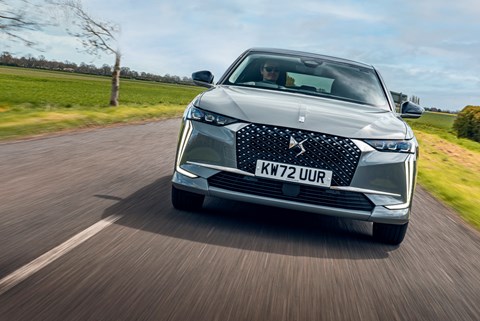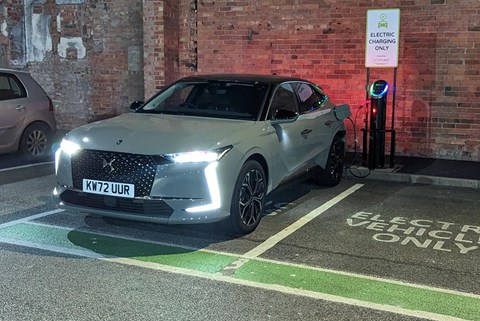► Opinion: ‘PHEV guilt’ is real
► While EV owners can worry about when they can charge…
► …PHEV owners stress about *not* charging
‘Range anxiety’ is one of those phrases that has hung heavy on the shoulders of the EV for years. You might argue that it’s nowhere near that big of a problem anymore (and I’d agree), but no one can deny it’s a term that’s dogged battery electric cars.
We know this at CAR. One of the biggest questions we get asked about EVs is how far it can go on a charge. We’ve done massive tests about the real-world range in the worst conditions (like our EVs vs Winter test – read it here!), and have just done a big feature on the current state of the UK charging infrastructure.
But, alongside battery-electric car take-up, the plug-in hybrid is proliferating daily life, too. Car makers like BMW with its latest 5-series, for example, aren’t bringing diesel options to the UK anymore because demand has collapsed – both privately or via a company car scheme. In 2023, diesel sales have continued to shrink, with figures dropping from 46,028 in the first half of 2022 compared to 37,456 during the same period this year. PHEV registrations, meanwhile, climbed from 51,263 in H1 2022 to 62,155 in H1 2023, according to data from the Society of Motoring Manufacturers and Traders.
And attractive tax benefits make plug-in hybrid ownership appealing here. So much so that I’ve had a family member choose a PHEV over a regular combustion engine car as their new company motor, simply because the tax burden was halved if they electrified – despite not having the facility to charge it at home.

I am currently in the same position. As I write this, I’m running a DS 4 E-Tense (pictured above) on CAR’s long-term test fleet (which you can read about here if you’re a member), and I don’t have the facility to charge at home as my parking space is nowhere close to the actual structure of my house. Instead, I’ve changed my daily structure to come into the Bauer office as much as possible (ah, the benefits of flexible office working!) to keep the battery topped up. My commute is short – only around seven miles – meaning I can plug the DS in every other day and still get to work and back without the engine ever firing. But, for longer distances, it’s not that simple.
And this is where I’d like to coin a new phrase to rival EV range anxiety: PHEV guilt.
Why guilt? Well, for a number of reasons. The first mainly surrounds the electric part of a plug-in hybrid car’s powertrain. You’ve either invested your hard earned (likely more up front than a comparative petrol or diesel car) or decided to save money on your company car bill to electrify, with the intention of reducing your fuel bills if you’re using a PHEV properly. A noble goal.
In order to do so, that means keeping the car in its electric mode as much as possible. If you’re like me, your eye twitches when the engine wakes up, so you drive it gently enough not to pass the threshold on the car’s power meter where it would. I obsess over keeping the engine off when I know the journey is short enough with ‘my’ DS, even if it requires stints on the motorway. That, in turn, means keeping an eye on where charging points are – sometimes to the same regular intensity as an EV owner would.
‘Well duh,’ you might say, ‘that is the point of running something that has a plug socket.’ Yes, true. But the plug-in hybrid, by design, isn’t beholden to just running in electric mode – it has an engine it can lean on for longer journeys. And yet, I feel guilty when the engine comes on, like I’m doing things wrong.
And then, that guilt is compounded when you do come to charge it. For the most part, plug-in hybrids can’t use rapid chargers (the likes of the Defender P400e and Merc’s E-Class and S-Class hybrids are some of the very few that can), meaning you’re almost always relying on lamp-post chargers or slower 3 and 7kW ones in car parks.

Those aren’t massively common in my experience. And, if they are present in a place I’m going to stop, there’s usually only one point (despite it usually being in a car park like the one above that includes tens, if not hundreds of spaces). The flaw of the PHEV (among a few others, I will admit), is that public charging is slightly looked down upon by EV owners. And I get it – I have a backup power source to continue driving, they don’t. And that only adds to the guilt if I decide to plug in, as well as the potential sting of pricey public charging.
And therein lies the issue. As I’ve said to many people prior, PHEVs only really work (and achieve even something close to those wildly high claimed fuel economy figures) if you use them properly and have the use case for them. And that’s ‘properly’ as in: you have a relatively short commute and plug in whenever you can (ideally at home, too), as well as driving efficiently.
Is it just me that feels the need to self-flagellate over this? Or is this merely the accepted penance of owning the halfway house that is the plug-in hybrid? If it is, then I’m wondering to this day what on earth I’ve done for my sins.